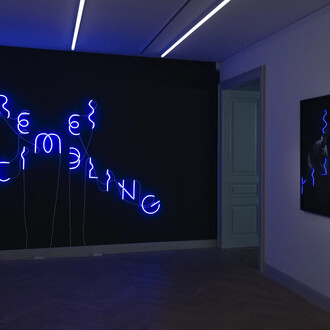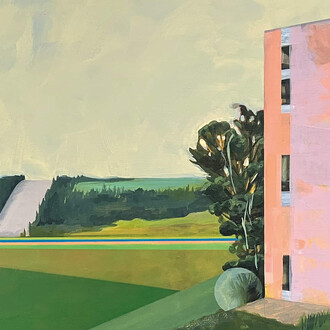For her solo presentation at the Kunsthaus Baselland — her first institutional solo show in Switzerland —, Rossella Biscotti premiers her five-channel video installation The City, 2018, on her extensive research and filming of the Çatalhöyük archaeological site, Konya, Turkey. Biscotti investigates the relationship between the neolithic community that built the earliest urban centre known to date and the archeological community that has been unearthing it over the past twenty-five years.
Does the study of ancient artefacts and cultures provide a mirror with which we can consider the subjective values held by researchers in their own society? Biscotti worked closely with Ian Hodder, leader of the Çatalhöyük Research Project and Professor of Social Anthropology at Stanford University, and his international team, filming during the 2015 and 2016 excavation seasons. Since 1993, Hodder, one of the key thinkers of the post-processual school, has put his ideas to the test at Çatalhöyük. These include decentralised project management teams, self-reflective and diaristic reporting, co-authorship and data sharing and an understanding of the site as a living community uniting both professional agents and local actors. When on site, Biscotti recorded how these methods were activated in order to study an ancient people whose own community underwent various radical socio-economic changes.
Inhabited for a period of almost 2,000 years (circa 7500 to 5700 BC), Çatalhöyük has eighteen layers of occupation and was once home to a “proto-city” of nearly 10,000 people centred on a honeycomb maze-like complex of shared buildings that grew both out of and on top of each other. The film looks in particular at these urban forms in which distinctions between public and private were rather fluid, while also investigating the site’s complex burial rituals in which the dead were interred amongst the living. Likewise, evidence of the division of labour, between what was produced where and by whom on the site, seems to suggest a society with little to no social or gender stratification. These organisational principles, which show how another, possibly more liberated form of society functioned, are contrasted with the dig’s modern context in order to consider how our own social constructions have also advanced.
The 2016 season stopped abruptly due to the attempted military coup d’état in Turkey. The season would be the last of Ian Hodder’s twenty-five-year project. Rossella Biscotti was then on the first day of her second year’s filming and she adjusted her script to record the bureaucracy of closing the site, the meetings, the departure of the community and the empty landscape that remained.
In her multi-media practice, cutting across filmmaking, performance and sculpture, Biscotti explores and reconstructs obscured moments from recent times, often against a backdrop of state institutions. The site of investigation tends to leave its mark on her sculptures and installations as she composes new stories from personal encounters and oral interrogations. By examining the relevance of the recovered material from a contemporary perspective, Biscotti sensitively weaves a link with the present.
This weaving is what interested me the most and what I found most relevant to narrate today… Rossella Biscotti in conversation with Ines Goldbach (April 2018)
Ines Goldbach (IG): You are showing your multichannel video installation The City for the first time here at the Kunsthaus Baselland: a project you’ve been working on for some years now. The film contains a series of video notes shot at the Çatalhöyük archeological site during 2015 and professional footage shot during the 2016 excavation season. Archeological sites seem to guarantee that we are able to understand our past and maybe also understand why societies collapse. So it could be helpful for us today looking at our future. What interested you the most about this project, filming this society of archaeologists trying to understand a former society?
Rossella Biscotti (RB): When I first visited the site, I was struck by the architecture: a reversed cityscape with connected spaces that had grown both side by side and on top of each other, horizontally and vertically. My view from the top, and the working of the archeologists in plots below, reminded me of a Tati movie. I had read about the Neolithic revolution, how that civilisation underwent various and radical socio-economic changes, and how Ian Hodder, the project director, had been unveiling the site and his narration also by building up a living community of archaeologists, anthropologists, scientists and local actors who experimented with decentralised project management teams, self-reflective and diarist reporting, co-authorship and data sharing. I looked at them and the way they unearthed the stories; they analysed the data, making hypotheses on how that society radically modified the natural environment domesticating plants and animals, constructing for the first time a way of living together in an interdependent structure that also kept a strong connection with history, with ancestors, thus creating a complex ‘web of relationships’ and time-history. This weaving is what interested me the most and what I found most relevant to narrate today.












